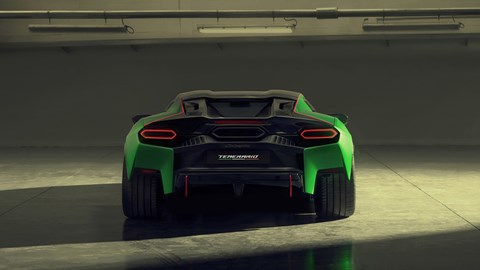► New Temerario supercar launching 2025
► Huracan replacement gets 4.0-litre V8
► With two turbos, three electric motors
Depending on which translation you believe, the latest Lamborghini – called the Temerario – translates as reckless, rash or daredevil. In other words, exactly what you expect from a Sant’Agata supercar. It’s also not a huge surprise to see the spine-tingling naturally aspirated V10 dropped (RIP) for a smaller, yet more powerful 4.0-litre twin-turbocharged V8 plug-in hybrid.
After all, if even its flagship Revuelto hypercar isn’t safe from hybridisation then its little sibling surely must go the same way. For Lamborghini, hybrid is by the preferable option when the alternative is full EV.
Company CEO, Stephan Winkelmann, was quoted as saying ‘we don’t see hybrid technology as bridging tech anymore, we see it as something that could be here to stay. In our opinion, the supercar should stay hybrid as long as possible’. Some endorsement from the man at the top, and of course Lambo’s take on PHEV is more eye-catching than most…
907bhp and a red line at 10,000rpm
We’ll start with some numbers. Because even by today’s standards of amply powered EVs, the Temerario still stands out. On its own, the engine makes 789bhp and 538lb ft of torque, but together with the three axial flux electric motors (two on the front axle, one sandwiched between the engine and eight-speed dual-clutch gearbox) total outputs are even more mind-blowing.
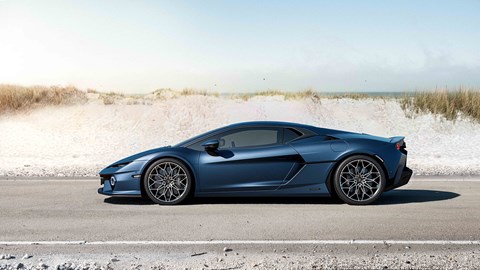
Remember when the Gallardo initially released with circa 500bhp and the Huracan with 600bhp, that seemed like a lot? The Temerario blows that away with 907bhp. Together with all-wheel drive, that means standing launches to 62mph take just 2.7 seconds (0-125mph in just 7.3 secs) and top speed is quoted as 213mph.
Perhaps most impressive of the lot however is the way the Temerario promises to rev. Twin-turbo V8s don’t tend to rev especially high, but Lamborghini’s unit doesn’t hit the limiter until 10,000rpm. Impressive stuff. And – less important – the 3.8kWh is probably good for around 9 miles of EV range, not that anyone is especially fussed given Lambo is very clear that it’s their for performance rather than efficiency. Charging takes 30 mins on a 7kW charge and six mins from the engine itself.
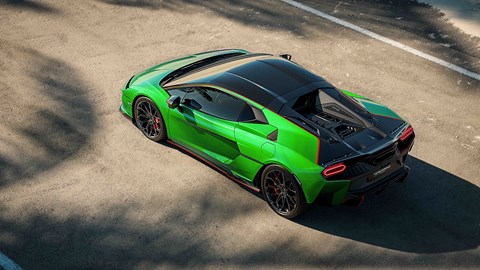
As for the gearbox, an eight-speed DCT transmission is installed transversally in behind the twin-turbo V8. In order to save space and weight, an additional hollow shaft is used to share the same synchronisers for different gear torque paths, meaning a number of electrical components can be jettisoned. Hence why the eight-speed DCT in the Temerario weighs less than the Huracan’s seven-speed DCT yet achieves faster shift times.
How does it sound?
Well, we can’t be sure yet. Our experience hearing the engine was from static revving in a sound-deadened room (never the best way to showcase a car’s lungs) and from a computer simulator. From these early impressions, we’d be very confident in saying that the new V8 won’t be on the same level as the V10 – big surprise – but equally there’s a lack of characterful intake noise, while the in-car sound symposer seems to do plenty of heavy lifting. We’ll wait to make our final judgement once we’ve heard the engine under load!
The styling is classic Lamborghini
If the engine sound isn’t quite what you were expecting, there shouldn’t be anything about the styling that doesn’t fit in the Lamborghini playbook. Loud, angular and a little on the crazy side, it’s a worthy follow-on to the Huracan and, in some ways, is even more extreme.
Walk around to the rear end for example and while there’s no huge spoiler (yet), the diffuser makes up for that. As vast as it is aggressive and punctuated by a GT3-esque fog light, it provides the perfect complement to the letterbox single exhaust and ludicrous cut-away wheel arches. The hexagonal lights, too, are a wonderful piece of detail.
Of course, all of that isn’t for show. Rear downforce is up 103% compared with the Huracan EVO, going up to 158% when the lightweight Allegeritta Pack is specced. This offering a saving of up to 27kg (much carbon involved) and increased aero load by 67%.
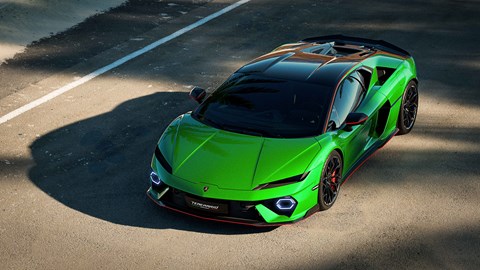
Further forward there’s huge side radiators that guzzle airflow carefully channelled via elements such as the wing mirrors and DRLs (with their own built-in intakes and deflectors). Four-pot calipers at the rear and ten (!) at the front mean the stopping distance from 62mph is just 32m. Admittedly, that’s 1m further than the Huracan Performante but when you factor in that car’s dry weight of 1,382kg versus the Temerario’s 1,690kg it’s a whole lot more impressive. Too heavy for a supercar? We’ll see.
Revuelto copy cabin is exceptional
It was obvious when the Revuelto launched that Lamborghini had spent a lot of cash on the cabin, so it was hardly going to rip that up and start again when it came to the Temerario. As such, it’s very similar to big bro with three screens across the interior (digital dash, central infotainment and passenger information display), a whole lot of hexagons and no shortage of space.
In fact, Lamborghini’s been on a mission to drop the notion that its cabins are super compromised, cramped cockpits for two highly flexible individuals. For example, the Temerario’s new aluminium space frame (torsional stiffness is up 24% FYI) improves headroom by 34mm, legroom by 46mm and even grants enough space for 18-way electrically adjustable heated and cooled seats.
But what we really like about the cabin is the appreciation of the humble button and switches. To some, the steering wheel might look a touch busy, but crucially the number of physical controls mean everything is clear and easy to control. No fumbling with touch pads or sliders, everything is operated very deliberately. This includes the drive modes, of which there’s five (Città, Strada, Sport, Corsa and Corsa Plus) and the powertrain settings (Recharge, Hybrid and Performance), as well as another dial for drift mode – of course.
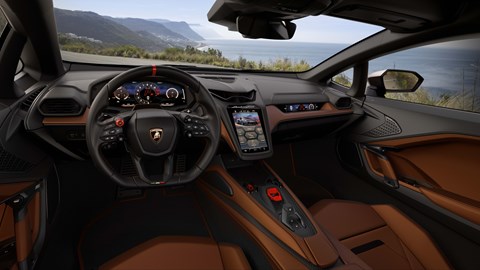
Something else that caught our attention is the LAVU system. Sounds like a disease, but it actually stands for Lamborghini Vision Unit. It uses three 4K cameras and provides features such as – Lamborghini Telemetry 2.0, Memories Recorder and Dashcam. The first is a continuation of a feature seen in the Huracan STO and records circuit sessions and telemetry at over 150 circuits around the world, even displaying tire pressures and ESC intervention, as well as the user’s heart rate thanks to Apple Watch integration.
Meanwhile, the Memories Recorder can be used to capture the expressions of unsuspecting passengers the first time they feel the might of 907bhp, while the dash cam function is, well, a dash cam…
How much?
No word yet from Lamborghini on how much the Temerario will cost, but don’t be surprised to see a highly specced version list at over £300k. The final Huracan will roll off the production line later in 2024, with deliveries of the Temerario expected in 2025. Keep an eye on the CAR mag website for our first drive of Lambo’s new baby supercar in the next few months!
